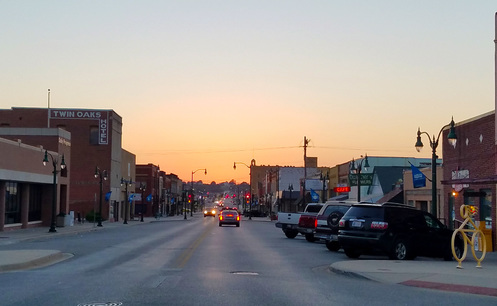 Three blocks of downtown Claremore received a new designation last month as the National Parks Service officially added the district to the National Register of Historic Places.
Three blocks of downtown Claremore received a new designation last month as the National Parks Service officially added the district to the National Register of Historic Places.
The National Parks Service made the announcement weeks after receiving the nomination from the State Historic Preservation Office (SHPO).
“We are so excited to receive this exclusive designation,” said Jessica Jackson, Claremore Main Street executive director. “Our volunteers have worked tirelessly on this project to benefit our district and further development in downtown Claremore.”
Included on the Register is the area between Route 66 and Muskogee Avenue and from 4th Street to the alley between Will Rogers Boulevard and Patti Page.
The National Register of Historic Places is the official list of the Nation’s historic places worthy of preservation.
“Authorized by the National Historic Preservation Act of 1966, the National Park Service’s National Register of Historic Places is part of a national program to coordinate and support public and private efforts to identify, evaluate and protect America’s historic and archeological resources,” its website states.
The designation came after years of the research and application process by Claremore Main Street volunteers alongside the State Historic Preservation Office.
Main Street Board of Directors Treasurer Ray Brown and former executive director Cindy Bissett, along with other community members and volunteers, spent hours poring over research, talking to former residents and property owners and going through property records to complete the application and narrative.
“With the National Park Service designation, downtown Claremore has another major attraction to the City of Claremore,” Brown said. “With the historical structures downtown and the anticipated renovation, Claremore will attract even more people to the downtown area.”
Brown said when he first heard about the project, he knew it fit exactly in his area of expertise, and that he wanted to have a significant role in the project.
“I was formally educated in demography and economic development; I have a lifetime interest in conducting research,” he said. “I love Claremore with its downtown area that is beautiful and historically significant, and I desire to see the City and its downtown area prosper.”
One of the major benefits of the designation to the National Register is that building owners will be able to make use of federal tax credits to revitalize or renovate their building, which would lead to some façade updates and upper floor development within the downtown district.
“Owners of qualifying buildings in the historic preservation district may receive federal and state tax credits up to 40 percent, “ Brown said. “Encouraging reinvestment creates for the owners more valuable assets which are very functional in today’s commercial and social environment.”
Other benefits include the tourism perks and protection from federal government projects that may harm the district.
“The Downtown Claremore Historic District will join the Will Rogers Memorial Museum, the J.M. Davis Arms & Historical Museum, the Claremore Museum of History and many other attractions to become part of a true ‘destination center’ attracting visitors and encouraging business investment,” Brown said.
There are no regulations on property owners or what they can do to their buildings unless they wish to qualify for the tax credits.
Additionally, Claremore Main Street’s Board of Directors say they hope to see the status boost tourism, especially among those traveling along the Route 66 corridor.
“Being named to the National Register of Historic Places is quite an honor,” Jackson said. “We hope those travelers who love seeing historic sites will be sure to put us down as a stop. We have beautiful historic buildings, great culture and modern amenities perfect for any wanderer.”
The historic district is significant for its role in commerce in Claremore from 1890 to 1955. This area has been the center of commercial development in Claremore from shortly after its founding in the 1880s to the present.
The vast majority of the buildings were completed by the 1930s, with most commercial construction activity after this time being renovations.
The buildings in the Downtown Claremore Historic District reflect the commercial growth of this community, growth spurred by transportation routes like Route 66 and the two railroad systems, transportation related activities and the radium water bath industry.
The National Register of Historic Places includes individual buildings as well as entire districts like downtown Claremore.
Claremore’s district was one of eight new designations in the state and the only district included. In all, there are more than 90,000 properties nationwide included on the register, including 1,306 in Oklahoma and 107 districts.
“Someday, not too far in the future, visitors going on self-guided tours of historic downtown Claremore will be common place,” Brown said. “Becoming a National Historic District opens so many wonderful opportunities, I can hardly wait to see the many developments that will come.”
